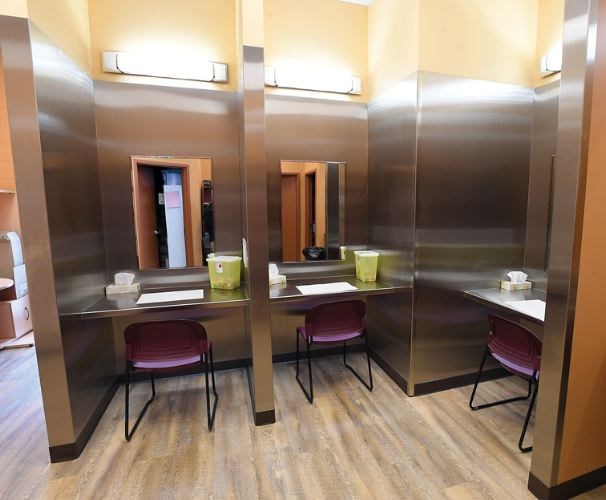Faced with an increasing demand for harm reduction services, northern B.C.'s only overdose prevention site is in the midst of a significant renovation and expansion.
The site has seen close to 6,000 visits between December 2016 and March 31, 2018. The demand has exceeded the site's capacity; the overdose prevention site, has largely consisted of a single stall beside the front reception area of the needle exchange clinic on Third Avenue and George Street. After renovations are complete, a back portion of the office will be opened up, with three stainless steel, ventilated stalls. Each stall will have a mirror affixed to the front wall, to allow proper sight lines of injection of narcotics by trained nurses, as well as a bin for needle disposal.
Staff on-site are able to intervene in case of an overdose.
Other services, such as immunization screening for HIV and Take Home Naloxone training, will continue to be offered at the site.
Prince George's overdose prevention site opened in December of 2016. B.C. had experienced a sharp rise in the number of overdose deaths, linked to a contamination of B.C.'s drug supply by fentanyl and carfentanil.
"We were having people overdose right on the corner, in the alley, right around the needle exchange. People knew how dangerous the drug supply was, but they depended on it. So they used at least near somebody that would be able to help them," said Northern Health medical health officer Andrew Gray.
"It was quite stressful for this to happen. It's not a very safe way to respond to overdoses."
Although Prince George has experienced a lower proportion of deaths attributed to opioid overdoses than other urban areas like Vancouver or Victoria, the city has still seen a sharp rise since 2015. Prince George saw 12 overdose deaths in 2015, 19 in 2016, 22 in 2017 and 8 over the first two months 2018 according to the B.C. Coroners Service.
But Gray said the overdose prevention site, described by one CBC report as "a desk and a chair behind a filing cabinet," was in a space that had not been designed to meet the demands of the opioid epidemic.
"The clinic wasn't designed with that kind of service in mind. It was a traditional, small nursing clinic," Gray said.
"People would have to wait quite a while. Sometimes if people had to wait too long, they would just say 'well I can't wait,' and they'd go and use in the street anyway."
Health administrators have nevertheless claimed the site has had significant success. According to the B.C. Centre for Disease Control, between December 2016 and March 31, 2018, there were a total of 47 potentially fatal overdoses that were reversed on-site.
Unlike safe injection sites, such as Vancouver's Insite, overdose prevention sites do not require an application for exemption from federal drug laws. Most of the 25 overdose prevention sites in B.C. were established in December 2016 on an emergency basis in response to the opioid epidemic.
Gray said the renovations for the Prince George site are near completion. The expanded overdose prevention site will be undergoing a trial run over the next few weeks, with the expanded space coming into full use in May. Hours will remain the same, from 1 to 6:30 p.m. from Monday to Saturday.



